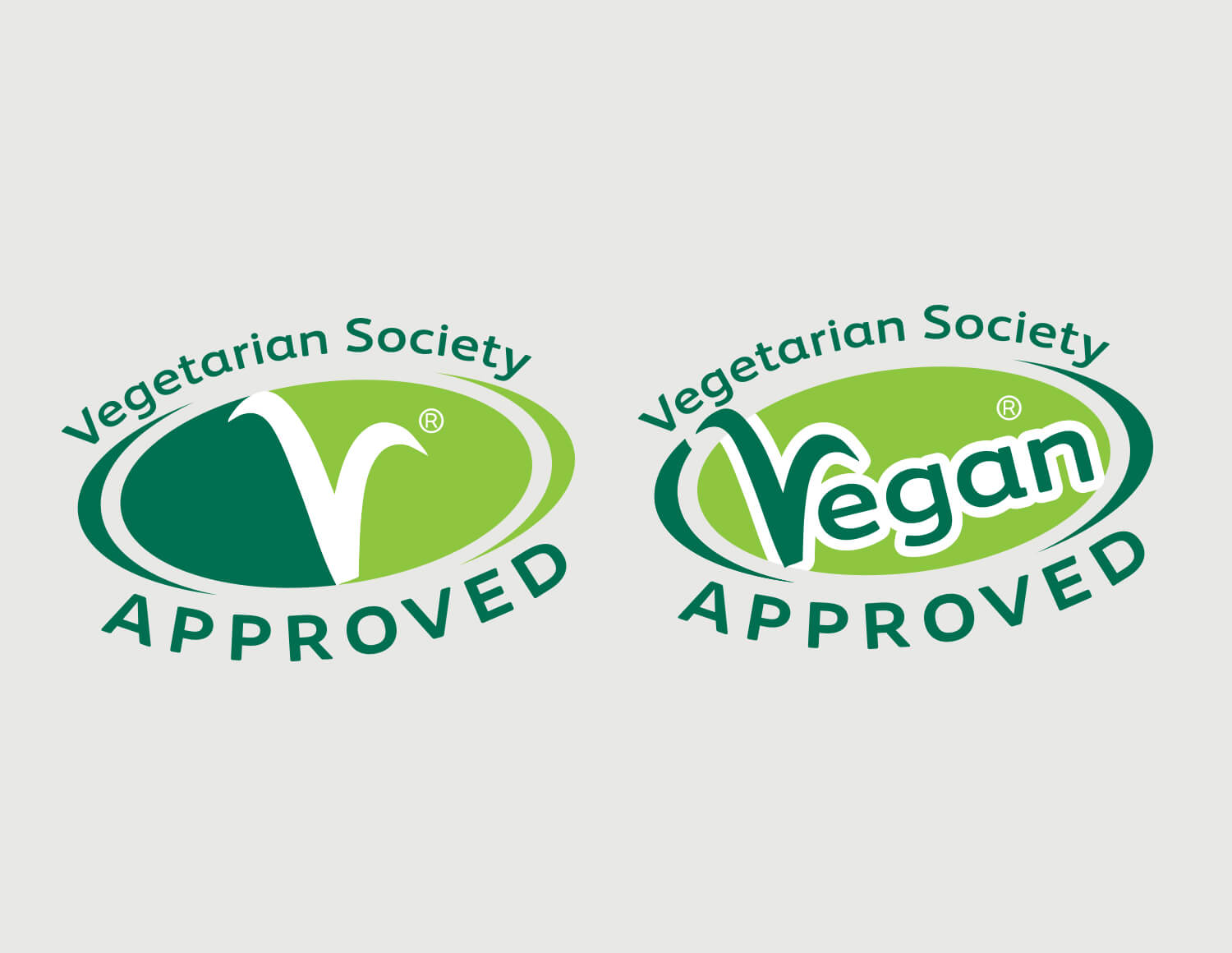E numbers. What you need to know…
Not all E numbers are suitable for a vegetarian or vegan diet. It can feel confusing when reading food labels but it doesn’t take long to get familiar with ones to watch out for.
If a product has the Vegetarian Society Approved vegetarian or vegan trademark on, you can be sure that the E numbers used are veggie and/or vegan friendly. If a product does not carry a Vegetarian Society Approved trademark, you can contact the manufacturer for further advice.

E numbers unsuitable for vegetarians and vegans
-
E120 Cochineal or Carmine
Used as a red food colouring in products, such as drinks, biscuits, sweets, desserts and sauces. It is made by crushing the cochineal insect
-
E542 Edible bone phosphate
Comes from animal bones of cattle or pigs. Sometimes used in cosmetics, toothpaste, nutritional supplements and in dry foods as an anti-caking agent, to prevent the particles sticking together.
E numbers unsuitable for vegans
CAUTION:
Label may not carry details. Look for the Vegetarian Society Approved trademarks
-
E901 Beeswax
Purified from naturally produced honeycomb. Found in glazing agents, candles, jellies, chewing gum and cosmetics, such as lip products and hand creams.
-
E904 Shellac
A natural polymer derived from the lac beetle. It has a number of uses, including being used to coat small chocolates and sweets as a glazing agent and to reduce moisture loss in fruit.
-
E913 Lanolin
A naturally-occurring wax extracted from sheep’s wool. Mainly used in cosmetics and some chewing gum. Lanolin is not always clearly listed as an ingredient in chewing gum, as it is only one component of the gum base. Gum base itself is listed as an ingredient.
-
E966 Lactitol
A sugar alcohol produced from lactose, which is the sugar in milk and is obtained from whey in cow’s milk. Used as a low-calorie sweetener. Found in calorie-reduced confectionery and chewing gum.
-
E1105 Lysozyme
Enzyme found in egg white.
E numbers sometimes suitable for vegetarians and/or vegans
-
E101 Riboflavin
A bright yellow food colouring found in salad dressings, confectionery, tablet coatings and powdered drinks. Riboflavin is also known as vitamin B2. It occurs naturally in foods such as milk and eggs as well as in green vegetables. When riboflavin is produced industrially for use as a food colouring, or for use in vitamin supplements, it is synthesised from glucose using micro-organisms, such as yeast without the use of milk or eggs. Industrially produced riboflavin (E101 and vitamin B2) is therefore typically vegan. However take care when selecting vitamin supplements to select those that are explicitly labelled either vegetarian or vegan as required, as capsules, coatings or other components of a supplement may be unsuitable.
-
E160a(i) mixed carotenes and E160a(ii) beta-carotene
Orange colouring usually isolated from plants but also made synthetically. Used in butter and soft margarine, cakes, milk products and soft drinks. Both E160a(i) and E160a(ii) do not easily disperse in water. Gelatine, which is not vegetarian/vegan, is sometimes used to micro-encapsulate particles of E160a(i) and E160a(ii), in products such as soft drinks, in order to make the colouring dissolve evenly.
-
E270 Lactic acid
Obtained commercially by heating and fermenting carbohydrates such as sucrose, molasses, starch, or whey. Occurs naturally in blood, so could conceivably be of animal origin. Often used as a pH regulator in dairy products and drinks. Found in soft sweets, pickled vegetables, low-fat mayonnaise and sour dough bread.
-
E304 Ascorbyl palmitate
A combination of the fatty acid palmitate with ascorbic acid, occurs naturally in most fruits and vegetables. Palmitic acid is produced from fat, the main source is vegetable fat but it can be obtained from animal fat. Found in margarines, oils and fats.
-
E322 Lecithin
Most commonly derived from soya and sunflower. Also present in eggs, milk and marine sources. Found in low-fat spreads, chocolate, dressings and bakery goods.
-
E325 Sodium lactate, sodium salt of lactic acid (also known as E270)
A natural acid produced by bacteria in fermented foods. Commercially produced by bacterial fermentation of starch, molasses or whey. Mainly used as a preservative. Found in some cheeses, sponge cakes, ice creams, margarine and sweets.
-
E326 Potassium lactate
The potassium salt of lactic acid. See E325 for more details.
-
E327 Calcium lactate
Calcium salt of lactic acid (E270). See E325 for more details. Used in tinned fruits and veg, in jams, jellies and marmalades.
-
E422 Glycerol/Glycerine
A natural carbohydrate alcohol, derived from animal or vegetable fats. Commercially produced in two main ways; synthetically from propene, or, by bacterial fermentation of sugars. Present in some chewy sweets, cakes and confectionery products.
-
E430 to E436
These compounds contain fatty acids which are mostly obtained from vegetable oils, however, there is a possibility that animal fats may be used. Typical products include cakes and cake mixes, dairy-based whipped cream, coffee whiteners, ice cream and frozen desserts.
-
E442 Ammonium phosphatide
Usually obtained from ammonia and phosphorylated fatty acids. Rapeseed oil is the traditional fatty source although vegetarians and vegans should take note as it can sometimes be made using glycerol (see E422). Found in cocoa and chocolate products.
-
E470 Fatty acid salts
Derived mainly from plant origin but animal fats may be used. Typically found in chewing gum, cake mixes and oven chips.
-
E471 Mono- and diglycerides of fatty acids, produced from glycerol (see E422) and natural fatty acids
Mainly from plant origin but animal fats may be used. Found in margarines, crisps, bread, dairy-free spread.
-
E472 Esters of mono- and diglycerides, esters of synthetic fats, produced from glycerol (see E422), natural fatty acids and other organic acid (acetic, lactic, tartaric, citric)
The fats are usually sourced from plants but animal fats may be used. Used as emulsifiers, stabilisers, thickeners and gelling agents in products such as sausages, cakes and mousse mixes.
-
E473 Sugar esters of fatty acid, produced from glycerol (see E422) and natural fatty acid
The fats are obtained mainly from plant origin but animal fats may be used. Found in some ice cream, tea and coffee powder drinks with added dairy powder and baking mixes.
-
E474 Sugarglycerides, esters of sugar and fats, produced from sugar and natural fats
The fats are mainly sourced from plant origin but animal fats may be used. Typical products include non-alcoholic drinks, bakery products and ice cream.
-
E475 Polyglycerol esters of fatty acids
A combination of polyglycerol and natural fats. The fats are usually obtained from plant origin but sometimes animal fats may be used. Found in icing, cake mixes, ice cream, coffee whiteners.
-
E477 Propane 1, 2 diol esters of fatty acids
A combination of propanediol and natural fats. The fats are mainly from plant origin but fats of animal origin may be used. Found in cakes and whipped toppings, soft drinks and powdered desserts.
-
E479 Thermally oxidised soya bean oil interacted with mono- and diglycerides of fatty acids
Made by heating soy oil in the presence of free fatty acids. The fatty acids are usually from plant origin but fats from animals may be used. Provides excellent frying and anti-spattering properties and used for frying purposes.
-
E481 Sodium Stearoyl Lactylate
An emulsifier used as an ingredient in some breads and bakery goods. E481 is made from lactic acid and stearic acid. The lactic acid used is made by fermentation of sugars and is vegan (no commercial forms of lactic acid are made from dairy milk). Stearic acid is often derived from palm fat but can be derived from animal fat that is of slaughter origin.
-
E482 Calcium stearoyl-2-lactylate
A combination of calcium, stearic acid and lactic acid, resulting in a mixture of several components. The original source of stearic acid can be plant or animal. Found in breads, hot drink whiteners and low-fat spreads.
-
E483 Stearyl tartrate
A combination of stearyl acid and tartaric acid. The origin of stearic acid can be plant or animal fats. Often used as a dough strengthener in breads.
-
E491 to E495 Sorbitans
Produced from sorbitol and varying acids. These are fatty acids derived from vegetable or animal origin. Used in cakes and fat spreads.
-
E570 Fatty acids
Which include stearic, palmitic and oleic acid. A normal part of any natural fat. Although commercially prepared using plant sources, the use of animal fat is possible. Typically found in chewing gum, butter, cosmetics and medicines.
-
E631 Disodium inositate
The sodium salt of inosinate, a naturally occurring acid mainly present in animals. Commercially prepared using meat or fish. May also be produced by bacterial fermentation of sugars. Used in soups, sauces and snack foods.
-
E635 Disodium 5’ribonucleotides
A mixture of sodium salts of guanylic and inosinic acid. Guanylic and inosinates are generally produced from meat or fish. Can be produced using vegetable and yeast sources. Used as a flavour enhancer, including snack foods, tomato-based products and other common processed foods.
-
E920 L-cysteine
Essential amino acid derived from proteins, synthetically produced, through natural fermentation, or enzymic processes, using raw materials of vegetable origin or pure organic, non-animal, compounds. May also be derived from animal hair and feathers. Used in baking to create stretchier doughs, especially for burger buns and pizza bases.


